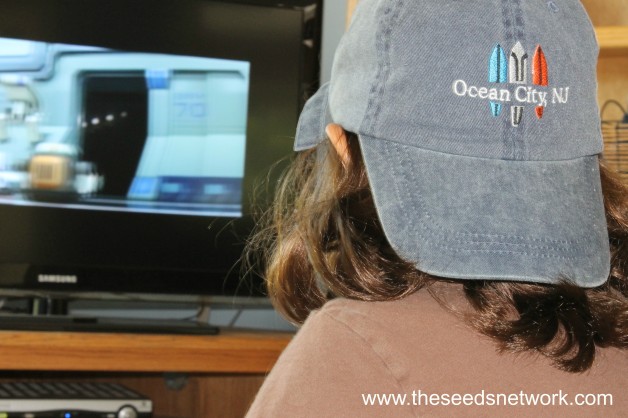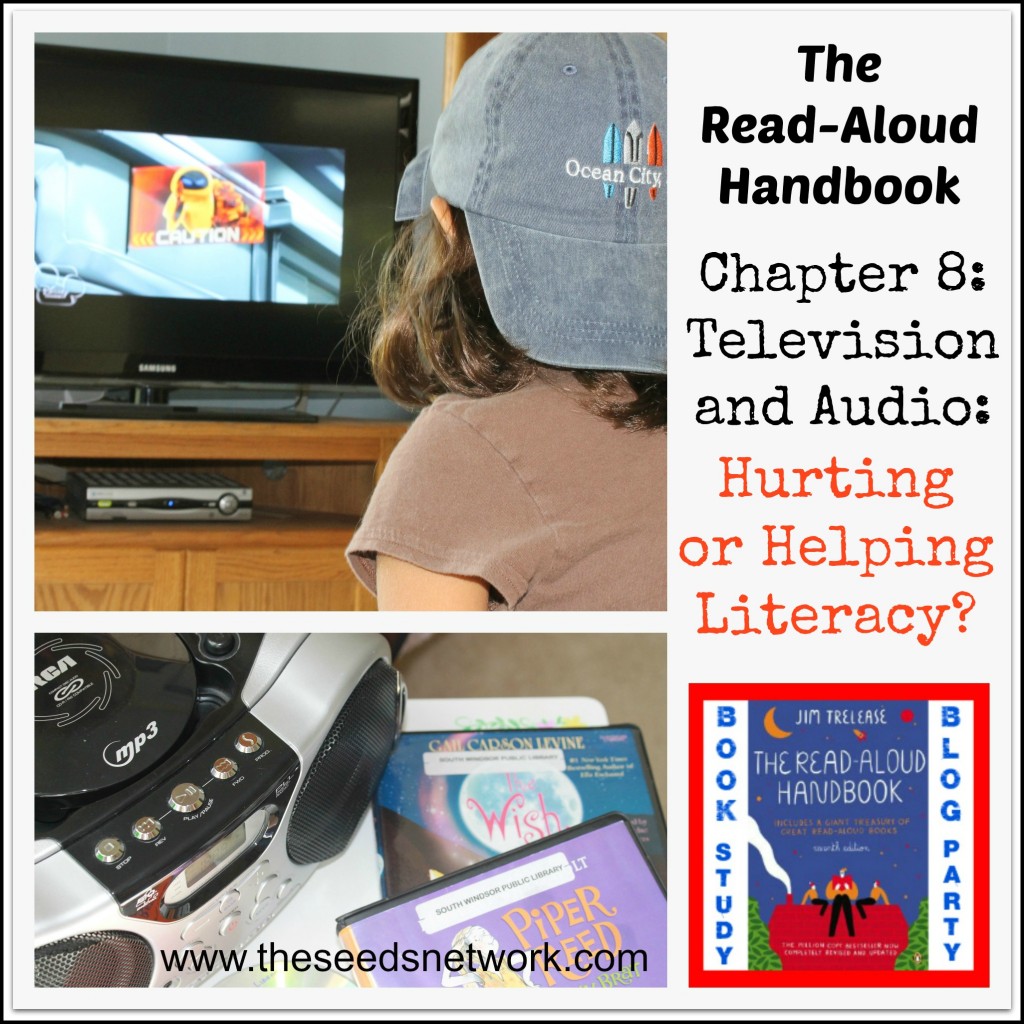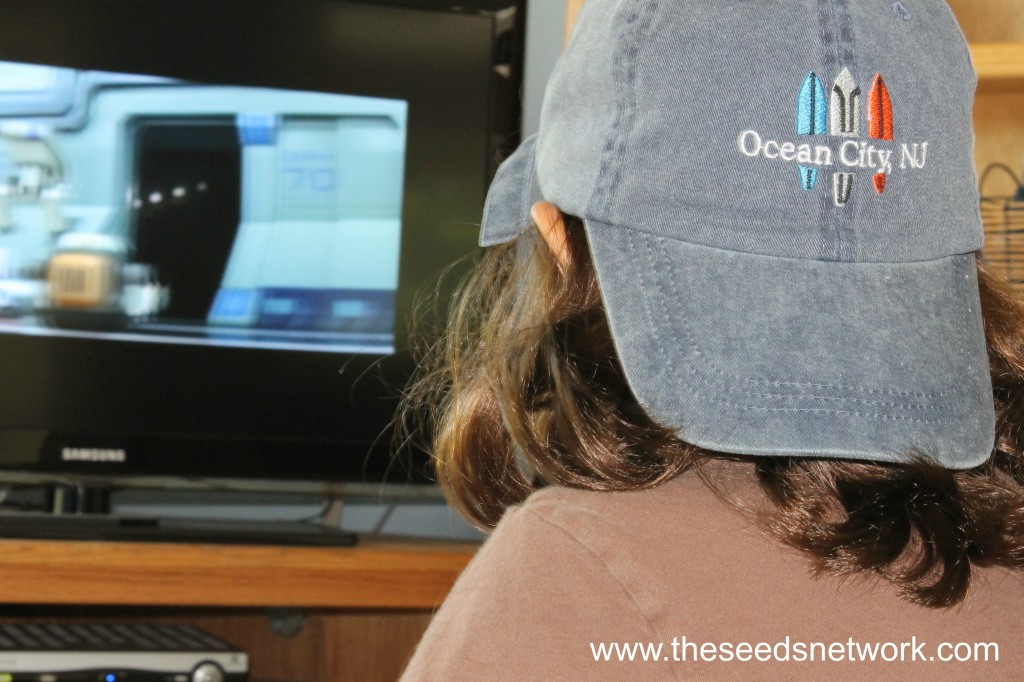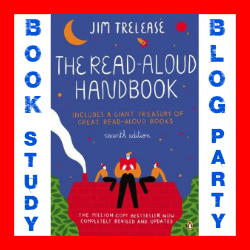We are continuing with the summer book study of “The Read-Aloud Handbook: Seventh Edition” by Jim Trelease with a review of Chapter 8: Television and Audio: Hurting or Helping Literacy?
Television
Talking about how much TV children watch can be a hot topic. And with the introduction of more and more “screens” in our lives (computers, electronic games, iPads, etc.) – monitoring a child’s screen-time can become a full time job for some parents. And parents not only need to consider the amount of TIME spent on these devices or watching TV — but the CONTENT has to be monitored as well. Mr. Trelease starts this chapter by asking about the presence of TV in the family … is it positive, negative or null and void?
Positives
Mr. Trelease mentions that television can play a positive role for information sharing and raising public awareness (think in terms of reporting on wars, 9/11 and natural disasters). And he also talked about the positive impact that Oprah’s Book Club had on reading. Television as a form of entertainment and information sharing can be harmless … (but here’s the key) … only in the right doses. Just like anything else that can be considered harmless or even good for us; in excessive doses those same things can become harmful. Children need our help in controlling how much TV and other “screen-time” they have so that the affects do not become harmful to them. I like TV. My kids like TV. But finding the right balance is important.
Negatives
It is not so much what children are doing while they watch multiple hours of TV; it is the experiences they are not having that make the viewing so dangerous. — [pg. 183]
I love that statement, because it is so truthful in it’s simplicity. To drive that point home, Mr. Trelease shares the incredible story of Sonya Carson (mother of Dr. Ben Carson) and how she controlled the dosage of TV for her children, and thereby affecting their lives in a positive way. You can read that synopsis of the story in this chapter or check out “Gifted Hands: The Ben Carson Story” by Dr. Ben Carson.
Does the amount of TV viewing affect literacy and learning? The American Academy of Pediatrics recommends a limit of 10 hours a week, and no TV for children under age 2. Mr. Trelease states that research findings show that school-age children, who watched up to 10 hours a week of TV showed no detrimental effects on learning. BUT, for children who watched more than that – scores began to decline (and the average student today watches three times that amount).
And again, he is quick to point out that in looking at the AMOUNT of TV viewing a child does … the academic damage that is being done is in what the child is NOT doing during that time.
While a child is watching TV, he/she is NOT …
-
playing games
- doing chores
- drawing
- working on a hobby
- playing with friends
- doing homework
- doing physical exercise, such as bike riding or throwing a ball
- READING!
All those things listed above are important for a child’s development – socially, emotionally, physically and academically. So again, in the simplest terms possible – if the TV is turned off more often – it frees up children to do other things that are important for their development. There are great examples of families who took control of TV viewing that you can read about in this chapter. I recommend giving it a closer look and taking away strategies that may work in our own homes.
Audio
This part is near and dear to my heart. My youngest is fanatical about books-on-tape. She listens to one every night (after her own reading or story read to her). So the question raised in this section is “are stories on tape OK for children?“.
If the audio is used as a full-time substitute for a literate parent, no, they’re not okay. But if used to supplement your readings or used by children whose parents are illiterate or unavailable, they are excellent!” – [pg. 196]
Whew! Again, it’s all in how the technology is being used. Mr. Trelease points out that as Americans spend more time in their cars listening to iPods; audiobooks have become more popular. This is a great example of how technology can be used to promote literacy.
Even when the audio story is used as “background noise” during a child’s play, they are hearing and learning new vocabulary. You can even take the available technology to another level by recording stories in your own voice, or having distant relatives do the same to add a personal touch to a favorite story (what a wonderful idea!).
Will audio books make children “print lazy”?
Mr. Trelease points out that it’s just the opposite – and that the biggest users of audio books were the most literate people in America. Thinking to all we’ve learned from previous chapters about how children can listen to a story that is at a higher level than what they can actually read on their own — it makes sense that a person who spends time listening to an audio book will continue to increase their vocabulary and story comprehension.
It makes me think back to this quote from Chapter 2 …
“Listening comprehension feeds reading comprehension.“ – [pg 67]
I hope you enjoyed this Chapter review. I am really learning a lot from this book and following along with others on this study. What do you think about Chapter 8? Is there anything you will do differently or will start to do in regards to your families’ use of TV and audio? Feel free to share your comments below!
Follow the book study
New to the book study? Visit the overview of the book study at Pre-K Pages.
Looking for next review? Next up will be a review of Chapter 9 from Matt at Look at my Happy Rainbow on August 5!
I have also put together a post with a timeline for the book study, so check that out as you read along with us!






Leave a Reply